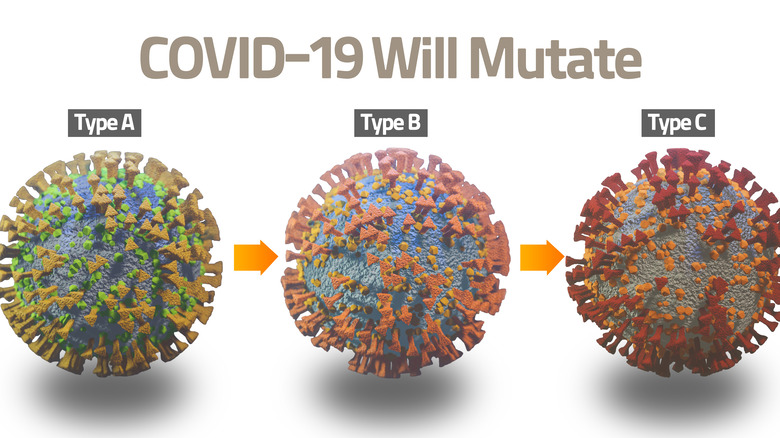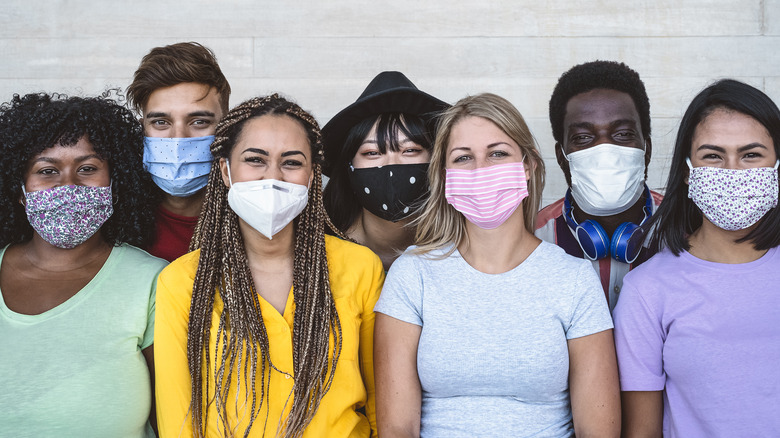Omicron: What You Need To Know About The COVID-19 Variant
On January 12, CDC Director Dr. Rochelle Walensky told reporters that, as of that date, the seven-day daily average number of new COVID-19 cases was up by 47% from the previous week (via White House). This seven-day new case average is more than double what it was exactly one year ago, per The Washington Post. And so it appears that the Omicron variant is quickly bringing COVID-19 to a much wider audience.
Omicron was first detected as a mutation by scientists in Botswana in early November 2021 (via The Lancet). Over several weeks, infections attributable to the mutated virus spread much more rapidly than any other prior strain of the novel coronavirus had thus far. The variant was confirmed to have reached the U.S. on December 1, according to the Centers for Disease Control and Prevention. By late December, the U.S. infection rate was already soaring. But how is that possible when over 63% of the U.S. is fully vaccinated? Here is what you need to know about the highly contagious omicron variant.
A Variant of Concern
Viruses are mercurial by nature. That's because a virus "survives" by attaching to a host, where it proceeds to reproduce itself over and over. However, changes — known as mutations – often happen during that process, according to the CDC. Mutations that end up being advantageous to the virus' survival are more likely to be repeated.
As of April 2021, the novel coronavirus already had 12,700 identified mutations and almost 4,000 variants (i.e., sequence of one or multiple mutations), Dr. Francisco R. Velázquez detailed in an article for Spokane Regional Health District. Obviously, not all variants, and certainly, not all mutations are considered to be of consequence to public health. A VOC is defined as "a variant for which there is evidence of an increase in transmissibility, more severe disease (for example, increased hospitalizations or deaths), significant reduction in neutralization by antibodies generated during previous infection or vaccination, reduced effectiveness of treatments or vaccines, or diagnostic detection failures." To be declared a VOC by public health authorities, a variant must be found to satisfy all of these unfortunate conditions.
On November 26, 2021, the omicron variant was officially classified by public health officials as a VOC, according to World Health Organization, and on November 30, the CDC concurred.
The omicron variant spreads throughout populations extremely quickly
From the time it was first identified, the omicron variant of COVID-19 already showed signs of being extremely transmissible, according to Yale Medicine. During the first two weeks after the variant was identified in South Africa, cases rose from 300 to 3,000 per day. By late December, it had already become apparent that omicron can and does spread to people who have been fully vaccinated against COVID-19 (via Reuters). It has also started infecting those who have already had COVID-19 (via Prevention). All such people, can, in turn, spread it to others, whether or not they experience symptoms.
Dr. Anthony Fauci told J. Stephen Morrison, senior vice president of the Center for Strategic and International Studies, "Omicron, with its extraordinary, unprecedented degree of efficiency of transmissibility, will ultimately find just about everybody" — although for those who have been vaccinated, the odds of hospitalization and/or death should be reduced (via CNN).
Scientists are still trying to understand why the omicron variant is so proficient at spreading so quickly through communities and larger populations. Possible reasons include the high number of mutations that have been identified in the omicron variant's genetic makeup, many of which are associated with enhanced transmissibility (via Yale). In addition, it has been observed that omicron multiplies particularly rapidly and builds to particularly high levels, as compared with the delta and other variants, according to research out of the University of Hong Kong.
Omicron symptoms tend to come on faster following exposure to the virus
When COVID-19 was first identified, scientists studied its apparent incubation period and concluded that after exposure to the coronavirus, it took at least five to six days for symptoms to present with symptoms or a positive COVID-19 test (via The Atlantic). A 2020 study published in the journal, Virulence, found a correlation between incubation speed and disease severity in COVID-19 patients. However, that was many mutations ago. Since then, each of the major VOCs has come with a briefer and briefer incubation period, regardless of degree of virulence (i.e., severity). When the delta variant was identified, the period was estimated at four days (via The Lancet). As concerns omicron, European researchers have suggested symptoms can appear, along with contagiousness, within as few as three days after exposure to the virus (via Eurosurveillance).
Some experts believe the omicron variant's compressed incubation period may contribute to its ability to spread so efficiently. According to Johns Hopkins epidemiologist Jennifer Nuzzo, the brief window between exposure and infection makes omicron "much, much, much harder to control," as compared to other variants (via The Atlantic).
The short incubation period poses testing challenges
Since the time that COVID-19 was first identified in 2020, its incubation period (i.e., the time that it takes for COVID-19 to cause symptoms or contagion after exposure to the novel coronavirus) has been cut almost in half, according to The Atlantic. As a consequence of this increasingly abbreviated incubation period, communities around the globe are facing an increased number of COVID-19 infections at any given time. The rapid spread and the shortened window from exposure to infection pose new challenges with regard to testing. That's because the less time it takes to go from exposure to development of a viral load significant enough to cause symptoms, or, in asymptomatic cases, to become transmissible, the smaller the window for meaningful testing. Adding insult to injury is the fact that PCR tests can take several days to come back (via Harvard Health).
Rapid testing, which can return results within minutes, may help, but they are not nearly as accurate as PCR tests, according to The Atlantic. Specifically, they may not always be able to pick up a COVID-19 infection at its early stages, even when the infection is already contagious. Making matters worse, the speed at which the omicron variant spreads means that more people are seeking out testing, and more often, with the result being that demand has been significantly outstripping supply (via The New York Times).
Symptoms may differ from those of other variants
COVID-19 is, by definition, a "severe acute respiratory syndrome," according to Medscape. The CDC notes that regardless of variant, the symptoms of COVID-19 can include fever, cough, fatigue, body aches, shortness of breath, headache, sore throat, a loss of sense of taste or smell, nasal congestion, and gastrointestinal distress, as well as many others.
According to the CDC's Mortality and Morbidity Weekly Report for the week of December 1 through 8, of the first 43 confirmed cases of omicron in the U.S., the most common symptoms were "cough, fatigue, and congestion or runny nose."
A December 16 research paper published in Eurosurveillance, which studied how omicron presented in around 80 people believed to have been exposed to at one social gathering in Norway, identified the most commonly reported omicron symptoms as cough (83%), runny/stuffy nose (78%), fatigue (74%), and sore throat (72%). Slightly less common were headache (68%) and fever (54%). Even more uncommon were a reduced sense of smell (12%) and a reduced of sense of taste (23%). By contrast, when first identified, COVID-19 presented most often with fever, cough, and a loss of sense of smell or taste, according to a 2020 study published in OTO Open. What the scientists could not tell, however, was whether these differences might be attributed to positive vaccine status.
Is the omicron variant really just a 'mild' version of COVID-19?
Many people who have tested positive for the omicron variant have observed that their symptoms have been relatively mild. This may be, at least in part, a function of where omicron tends to settle in the respiratory tract (via Reuters). Whereas earlier variants tended to settle in the lungs, omicron appears to affect primarily the upper respiratory tract (the nose and throat), according to The Atlantic. This has led to some confusion, however, with some people inaccurately believing that omicron is no big deal.
While it is true that a smaller proportion of people who become ill with omicron have ended up hospitalized or worse, hospitalizations and deaths continue to mount (via White House). And while many who have tested positive for omicron have reported mild symptoms, it's not entirely clear if it's because it has been impacting a younger, healthier demographic (via Yale Medicine). Or, perhaps, it may reflect that many people are experiencing mild symptoms because they are vaccinated against COVID-19.
According to Dr. Tedros Adhanom Ghebreyesus, director-general of the World Health Organization, "While Omicron does appear to be less severe compared to Delta, especially in those vaccinated, it does not mean it should be categorized as 'mild.' Just like previous [COVID-19] variants, Omicron is hospitalizing people and it is killing people" (via Twitter).
The risk of long COVID
By January 12, the omicron variant was already accounting for 98% of all new COVID-19 cases, according to the CDC's Dr. Rochelle Walensky (via White House). But omicron is not the only variant that is currently responsible for hospitalizing Americans. Indeed, Walensky has said that the majority of COVID-19 deaths are still coming from delta as opposed to omicron (via NBC News). However, it's hard to say what the future holds — including the potential for omicron to lead to "long COVID."
"What we know about long COVID so far, from all the prior variants, is that the severity of long COVID seems to be a function of the severity of acute illness. What we have so far learned about omicron is that it tends to be milder or a little bit less severe," Dr. Ziyad Al-Aly of A St. Louis Health Care System, who studies long COVID, told Healio. However, he continued, "I'll caveat that by saying that we're also still learning about omicron. Maybe in the next few weeks, we'll learn that death rates will go up — hopefully, that's not going to be the case. But so far, our knowledge is that omicron seems to be a bit milder than delta. And if that really holds, it may translate into less risk of long COVID."
You can get omicron more than once
Throughout most of the pandemic, it's been taken as a given that if you've been diagnosed with COVID-19, you will have a lowered risk of "subsequent infection" for a period of at least six months, thanks to your own immune system having built up ammo against COVID-19 (via CDC). However, "one of the key features of Omicron is that it's much more resistant to immunity, whether vaccine-induced or caused by previous infection," Dr. Thomas Russo, professor and chief of infectious disease at the University at Buffalo in New York, told Prevention. Contracting COVID-19 after you've already had it is known as "reinfection," as opposed to "immune escape" which is the term for infection after vaccination (via CDC).
A preliminary study published on medRxiv and awaiting peer review suggests that reinfection with the omicron variant may be possible even after a COVID-19 omicron infection. Indeed, Dr. Stanley Weiss, professor at the Rutgers New Jersey Medical School and the Department of Epidemiology at the Rutgers School of Public Health, told Prevention, "Yes, you can get Omicron twice." One reason may be the increased viral load that has been associated with omicron, according to Dr. William Schaffner, an infectious disease specialist and professor at the Vanderbilt University School of Medicine (via Prevention). The increased risk of reinfection associated with omicron may be something to consider with respect to your mask-wearing and social distancing habits.
Some monoclonal antibody treatments are no match for omicron
In November 2020, the FDA granted emergency use authorization to Regeneron's monoclonal antibody treatment (casirivimab and imdevimab) for people at high risk for severe COVID-19. Monoclonal antibody treatment involves an intravenous infusion of lab-grown proteins that mimic a healthy immune response in the presence of harmful pathogens (like the novel coronavirus). The FDA also later issued an EUA to Eli Lilly's monoclonal antibody treatment (etesevimab and bamlanivimab). In May 2021, the FDA granted EUA to GlaxoSmithKline's monoclonal antibody treatment, sotrovimab (via Reuters).
Unfortunately, supply chain issues limited the number of people with access to monoclonal antibodies by December, revealed Forbes. Then, when clinical studies began suggesting Regeneron and Eli Lilly's therapies might not be effective against omicron, the U.S. paused distribution (via Reuters). On January 24, 2022, the FDA officially revised the EUAs for Regeneron and Lilly's respective EUAs, "[limiting] their use to only when the patient is likely to have been infected with or exposed to a variant that is susceptible to these treatments."
However, the FDA explained, "Importantly, there are several other therapies – Paxlovid, sotrovimab, Veklury (remdesivir), and molnupiravir — that are expected to work against the omicron variant, and that are authorized or approved to treat patients with mild-to-moderate COVID-19 who are at high risk for progression to severe disease, including hospitalization or death."
We're getting closer to an omicron-specific vaccine and booster
The CDC notes that "current vaccines are expected to protect against severe illness, hospitalizations, and deaths due to infection with the Omicron variant." However," the organization continued, "breakthrough infections in people who are fully vaccinated are likely to occur. With other variants, like Delta, vaccines have remained effective at preventing severe illness, hospitalizations, and death. The recent emergence of Omicron further emphasizes the importance of vaccination and boosters."
COVID-19 vaccines do indeed appear to be helping prevent deaths and hospitalizations, all of which have gone down as more people have become vaccinated, despite the number of cases continuing to rise due to omicron (via White House). As response team leader Jeffrey Zients noted in his opening comments of the January 26 COVID-19 Response Team press briefing, "Vaccines remain our single-most powerful tool."
And it looks like that tool is on its way to acquiring some additional sources of power now that both Pfizer and Moderna have officially thrown their hats into the ring with regard to developing an effective omicron-specific vaccine and booster, respectively. On January 25, Pfizer, together with its partner BioNTech, commenced a clinical study on the safety and effectiveness of its prospective vaccine. The following day, Moderna began trialing its own prospective booster (via Reuters).
Pfizer expects to publish results from its study during the first half of 2022. As of this writing, Moderna's timeframe is not yet known.
Could omicron signal the end of the pandemic?
They say that those who ignore history are doomed to repeat it. In keeping with that sentiment, many are taking the time now to reflect on the 1918 flu pandemic. Like the COVID-19 pandemic, it claimed the lives of millions around the world — an estimated 50 million — according to The Washington Post. But by the dawn of the Roaring Twenties, the pandemic had pretty much run its course. Some infectious disease experts, including Dr. Keith Armitage, attribute the conclusion of last century's flu pandemic to both herd immunity and the virus mutating to become less severe (via Healthline).
Of course, that all took place over a period of around two to three years and, in a sense, vestiges remain even to this day, per The Washington Post. Still, some experts believe that omicron, with its extreme and rapid transmissibility and the possibility that it may prove to be less virulent than earlier variants, could be a harbinger of the end of COVID-19, at least as a pandemic as opposed to a fairly routine, fairly controllable virus.
"The 1918 influenza virus eventually mutated to the point of not having a high number of deaths. ... We may very well be witnessing this process with ongoing variants of SARS-CoV-2," virologist Dr. Rodney E. Rohde explained to Healthline. However, Rohde refrained from making actual predictions because there is simply "too much uncertainty" at this time.












